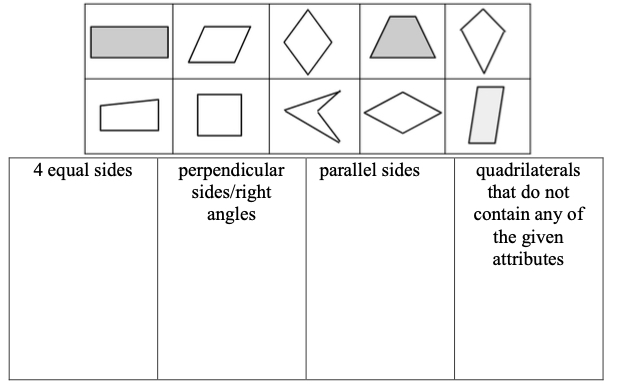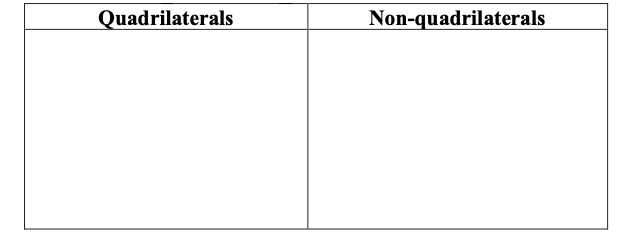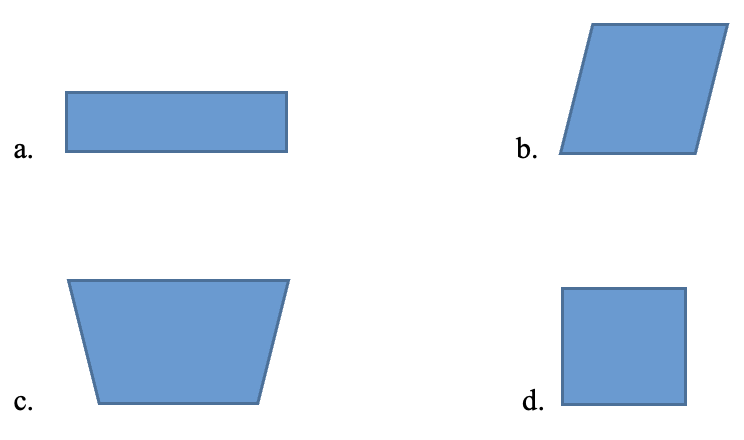General Information
Benchmark Instructional Guide
Connecting Benchmarks/Horizontal Alignment
Terms from the K-12 Glossary
- Line
- Parallelogram
- Rectangle
- Square
Vertical Alignment
Previous Benchmarks
Next Benchmarks
Purpose and Instructional Strategies
The purpose of this benchmark is to provide opportunities for students to apply their formalized definitions of geometric attributes when identifying and drawing quadrilaterals (MTR.5.1). With the support of vocabulary developed about geometric attributes in benchmark MA.3.GR.1.1, the goal of this benchmark is for students to identify and draw quadrilaterals based on them. In Grade 2, students started to explore and draw quadrilaterals in less formal ways.- This benchmark gives students opportunities to build vocabulary around examples of quadrilaterals (e.g., parallelograms, rhombi, rectangles, squares, and trapezoids) based on the attributes that define them. Understanding quadrilaterals will help them make comparisons to non-quadrilaterals (MTR.4.1).
- In Grade 4, students will classify types of angles and identify them in two-dimensional figures. In Grade 5, prior learning about quadrilaterals and triangles is synthesized for students to classify these figures based on their attributes.
- Instruction should include highlighting measurement as an attribute to help categorize quadrilaterals.
Common Misconceptions or Errors
- Students can confuse some pairs of intersecting lines as perpendicular. Encourage students to justify their thinking whenever they reason about geometric concepts. For example, students can use the corners of a standard sheet of paper as a comparison to determine whether a pair of intersecting lines is perpendicular.
- Some students may assume all quadrilaterals must have attributes of squares, rhombi, rectangles, squares, and trapezoids. During instruction, it is important for students to determine that a figure lacking further defining attributes (such as a kite) can still be a quadrilateral.
Strategies to Support Tiered Instruction
- Instruction includes real-world examples of points, lines, line segments, rays, intersecting lines, perpendicular lines, and parallel lines. The teacher provides images of real-world examples that include geometric figures. Students identify the geometric figure in the example.
- For example, the teacher provides an image of railroad tracks to represent parallel lines, a speed sign to represent perpendicular lines, a balance beam to represent a line segment, and other common images.
- Instruction includes real-world examples of points, lines, line segments, rays, intersecting lines, perpendicular lines, and parallel lines. The teacher points out items in the classroom that are examples of the geometric terms listed above and has students identify which term it is an example of.
- For example, if the teacher points out a poster with the number one or the letter l on it, students will say it represents a line segment. If the teacher points out the window, students will say the top and bottom of the window shows parallel lines, while the corners of the window show perpendicular lines.
- For example, students to find their own examples within in the classroom and explain which geometric term they notice in the figure.

- Teacher provides students with key vocabulary from the glossary to identify right angles to help them identify perpendicular sides in shapes. The teacher also provides a tool such as a square tile or the corner of a standard sheet of paper to help students find right angles. Students then matches quadrilaterals that contain this attribute.
- For example, the teacher provides a vocabulary card or vocabulary information from the glossary for a right angle, similar to the example shown below. Students then uses the tool provided to locate right angles and identifies which quadrilaterals contain that attribute when provided images of parallelograms, rhombi, rectangles, squares, and trapezoids.

- Teacher provides a graphic organizer to help students identify given attributes in figures. Students place the figures under the correct columns and identify quadrilaterals that do not contain any of the attributes stated.
- For example, the teacher provides sample figures and students draw them in or place the shape cards in the correct columns of the graphic organizer (some figures will fit in more than one column).

- Teacher provides figures that can be classified as quadrilaterals and those that are not (shapes may include: triangles, squares, pentagons, hexagons, square, rectangles, parallelograms, trapezoids, and other quadrilaterals such as a kite). Students sort the figures into two groups, quadrilaterals and non-quadrilaterals and justify their reasoning by explaining how they used the number of sides each figure has to determine their placement.
- For example, students will add figures to the chart shown below and explain why the figure belongs in that category.

Instructional Tasks
Instructional Task 1
Draw an example of a quadrilateral that does not have any defining attributes of a square (expect that it has 4 straight sides and 4 vertices). Then explain how you know.
Instructional Items
Instructional Item 1
Which of the following quadrilaterals always have 2 sets of parallel sides? Select all that apply.- a. Square
- b. Rectangle
- c. Rhombus
- d. Parallelogram
- e. Trapezoid
Which of the following quadrilaterals always have perpendicular sides? Select all that apply.
- a. Square
- b. Rectangle
- c. Rhombus
- d. Parallelogram
- e. Trapezoid
Which of the following quadrilaterals is NOT a parallelogram.

